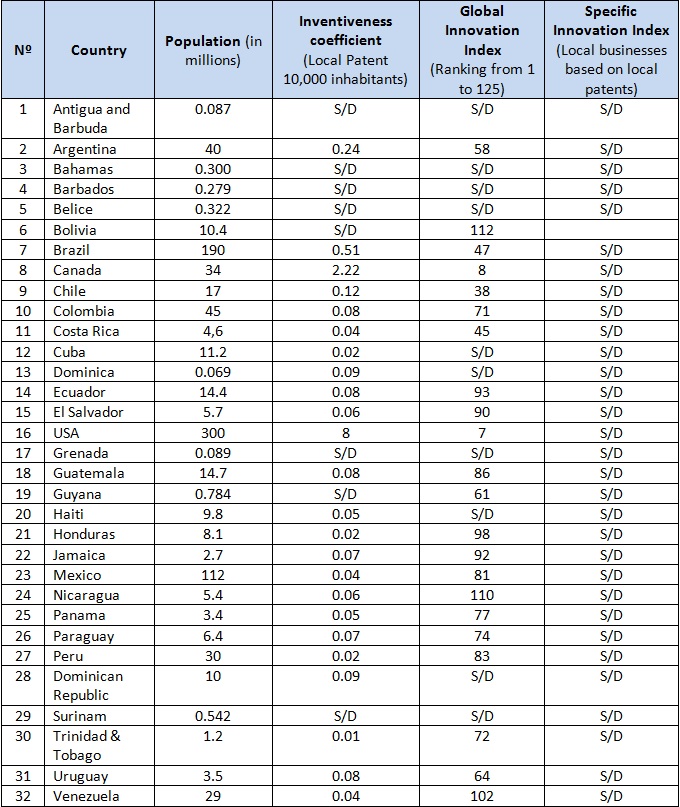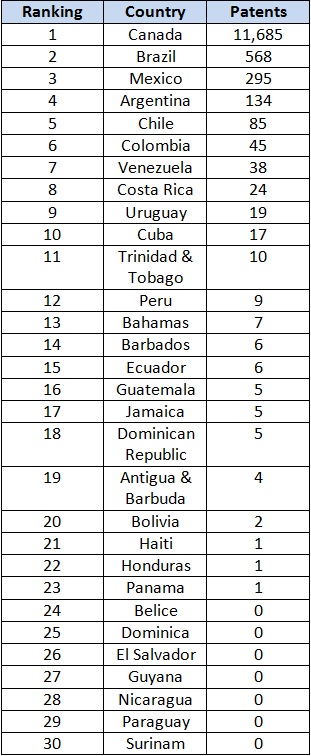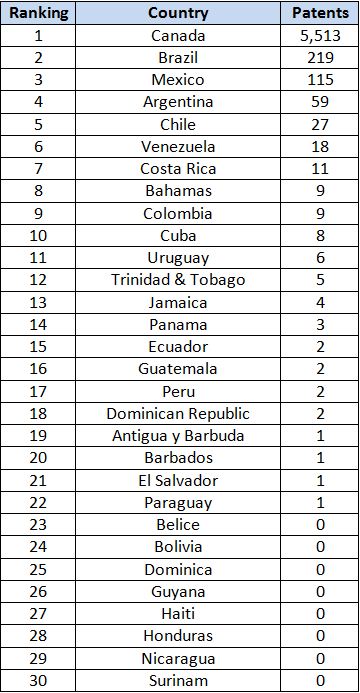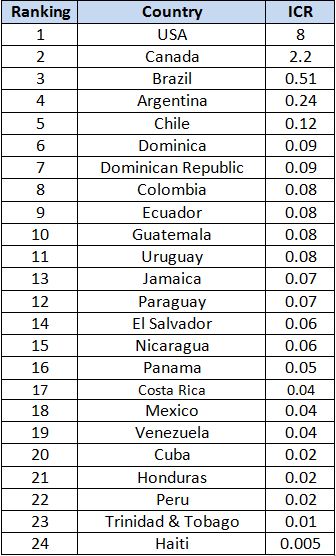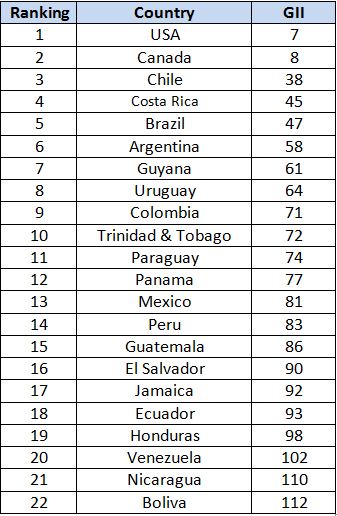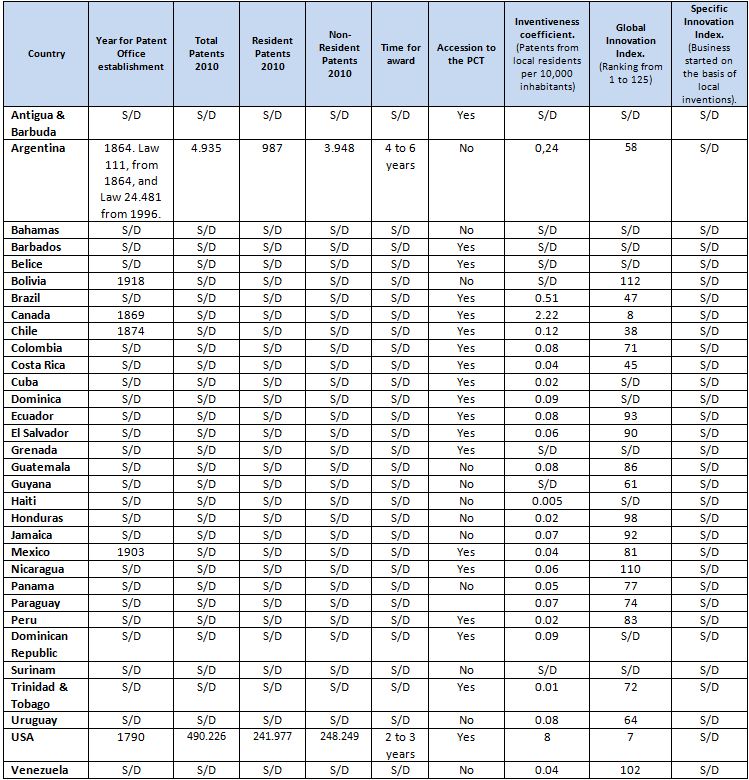Proposal – Contribution to WIPO
(World Intellectual Property Organization)
«SPECIFIC INNOVATION INDEX»
Prepared by
Mr. Eduardo Fernández1
Coordinator, Economic Opportunity and Prosperity Committee, IANA2
1 Mr. Eduardo Fernández is Professional Inventor, Director of the Argentine School for Inventors, and Director of the Argentine Inventors Forum.
2 The Author wish to thank the helpful assistance of Mr. Carlos Ojeda, from IANA’s Education Committee, who did all the translation work. Mr. Carlos Ojeda is also Chief of the Academic Department at the English Program in Basic Education of the State of Tamaulipas, Mexico.
A) OBJECTIVE:
To establish an index capable of quantifying the degree of social and economic impact, through technology based on patents developments, country by country.
B) INTRODUCTION:
If we only count the «inventiveness coefficient» which measures the number of patents for inventions of local residents, for every 10,000 inhabitants, or the «Global Innovation Index» (produced annually by INSEAD), it is clear that there is still no reliable and specific indicator to show, measure and compare the impact degree of local patent in local markets through the creation of companies that manufactured and marketed locally, or globally, these inventions and what are the factors and context promoting their development. From this stems the need for a «Specific Innovation Index». On the other hand, there should be a country-by-country in-depth analysis of links and implications:
1. Total number of patents per year.
2. Number of patents per year from local residents. (Individual, corporate or academic).
3. Number of patents per year for nonresidents.
4. Cost to start the patent process.
5. Time until formal examination.
6. Time to substantive examination.
7. Time to publication.
8. Time to grant.
9. Cost of the rate of concession.
10. Annuities Cost.
11. Merger or not to the PCT.
12. Number Patent Office employees.
13. Annual budget of the Patent Office.
14. Number of inhabitants.
15. GDP.
16. Government investment in R & D.
17. Private investment in R & D.
18. Growth rate in local patent applications.
19. Quantity SME’s (PyMEs), you create annually from one local patent.
20. Number of licenses to be awarded annually to local businesses on local patent.
21. Number of licenses to be awarded annually to foreign firms on local patents.
22. Necessary investement and time required to set up a new business.
C) METHODOLOGY:
- Research and comparative analysis of the information available in patent offices, ministries, universities and business chambers.
- Establishment of patterns, contexts and trends that favor an increase in the rate of innovation, country by country.
D) SOURCES OF INFORMATION AND SPECIFIC REFERENCES:
- Patent Offices.
- WIPO – World Intellectual Property Organization. (Statistics and general public).
- INSEAD – Global Innovation Index.
- OECD – Organization for Economic Cooperation and Development. (Oslo Manual on Innovation).
- UNDP – United Nations Development Programme.
- STIN– The Network of Science and Technology Indicators – Ibero-American and American.
- IDB – Inter-American Development Bank.
- WB – Wolrd Bank.
- ECLAC – Economic Commission for Latin America and the Caribbean
- WEF – WorldEconomic Forum.
E) ANALYSIS OF CURRENT SITUATION:
All indicators now available on this subject, are quantitative (number of patents, relations with the population, GDP, and the incidence of non-residents, etc.), but there is no reference of a qualitative nature, i.e., a reliable analysis that tells us how all this impacts particularly on the economy of a country. So that there is a blind spot in all the available information, thats why the need and opportunity to develop the concept of a «Specific Innovation Index.»
It is well known that the number of patents filed or granted in a particular country does not necessarily have a direct relationship with the innovation degree achieved.
Once the pioneers of the theory of Joseph Schumpeter and innovation as Peter Drucker, noted with emphasis that «innovation is the successful introduction of a new product, service or process in the market.» Then you can say that innovation is an outcome, not a process, and that, in any case, the process that leads to innovation is the «innovation management«, which encompasses leads and implements multiple variables, conceptual tools and best practices business.
In academic circles, is often put excessive emphasis on unreliable and misleading variables when trying to measure innovation in a country as its annual performance in the following areas:
a) The number of science graduate doctors.
b) The number of engineering graduated.
c) The number of published «papers».
d) The number of Innovation Centres created.
e) The number of patents granted.
f) The R & D government investment.
While these indicators are important and very necessary, are not sufficient to generate, measure and stimulate specific innovation, the real innovation of a country is reliable and accurate reading of the magnitude of the economic impact that has been generated through new knowledge in the form of patents.
On the other hand, as can be seen in Tables I, II, III, IV, V and VI, there is no direct relationship between the number of inhabitants of a country, its coefficient of inventiveness, and its global innovation index, either because the underlying data (when available), are incomplete, inadequate, or unreliable (because they are suspected of handling).
All these statistics, ratios and rates tell us nothing about the number of local companies created annually based on local patents, or how many licenses have been issued at both (global and local) to these patents.
There is also a clear gap in the excessive time involved the processing of a patent until it’s grant and the time needed to create a technology-based SMEs (PyMEs) in almost all patent offices in the region, except for the US and Canada.
Table I – Basic situation of the countries in the Americas
Table II – Applications for patents filed in the U.S. in 2010, by inventors from other countries in the Americas on a total of 490,226
Total: 12,972
(This represents 2.6% of total patent applications in the U.S.)
Table III – Patents granted in the U.S. in 2010, to inventors from other countries in the Americas, a total of 244,341
Total: 6,018
(This represents 2.4% of all patents granted in the U.S.)
Table IV – Inventive Coefficient Ranking for the Americas. (Local Patents per 10,000 inhabitants)
Table V – Ranking of Gobal Innovation Index for the Americas
Table VI – Global Comparative Analysis of the Americas
F) HISTORICAL EVOLUTION OF PATENT LAWS AND INTELLECTUAL PROPERTY:
From the beginning of the first law of patents, in the High Middle Ages, with the «Venetian Statute of the Inventor» to the most advanced of today’s laws, the primary objective has always been to promote and protect the creation of new companies based on new products that can produce wealth and prosperity for both inventors and entrepreneurs, and society in which they are immersed.
These principles and foundations, sometimes tend to be forgotten, distorted, or confused by academic criteria or directly by political manipulations that do not contribute to the «Innovation Management».
Some examples of the historical evolution of the protection and encouragement of innovation:
- The Venetian Statute of Inventor – (1474)
- The Charter of Privileges – James I of England – (1623)
- The Statute of Anne – England – (1710)
- Patent Office of the U.S. – (1790)
- French Patent Office – (1792)
- German Patent Office – (1815)
- Argentina Patent Office – (1864)
- Paris Convention – (1883)
- Berne Convention – (1886)
- Establishment of WIPO – (1967)
- PCT Creation – (1970)
G) SCOPE:
All this analysis and proposal, would be directed to constant monitoring to make an annual statistical report, interpretations and suggestions for improving innovation in each country, based on a very pragmatic approach: When, how much, and how the knowledge generated in one country, has created wealth in the form of specific companies, products, services or processes.
H) PRACTICAL APPLICATIONS:
Currently, all available information is incomplete, fragmented and of little practical value, which largely serves to justify much more pointless bureaucracy, and waste resources of all kinds. The availability of «Specific Innovation Index» would be useful for economic decision making, social and political, when allocating and managing resources and personnel. In annual terms qualitative and today nothing is known about how the knowledge generated by the general public, private companies and universities in particular, comes annually to the society in the form of new companies, products, processes or services . In the future, if this project is secured and has an effective working group, with the necessary resources could be generated publications, and provide services in the form of specific advice, seminars and training courses.
I) CONCLUSIONS:
1. There is no direct relationship between the scientific and technological production of a country with its level of innovation.
2. There are no reliable indicators to measure country-specific innovation, related to the creation of local enterprises based on local patents.
3. It is necessary to conduct a thorough investigation to develop a «Specific Innovation Index» as a reliable indicator that allows political and economic decisions for the better development of a nation. And as goes the classic concept of business management: «You can not manage what you can not measure.» Therefore, if you want or aspire to be successful in the «Innovation Management», we must first be able to have appropriate tools to create, stimulate and measure it.
J) PROPOSALS AND RECOMMENDATIONS:
1. Establish clear and practical criteria for a trustworthy measurement of the «Specif Innovation Index» (SII). Expressed on the basis of the result of dividing the annual number of local patents granted (LPG) by the number of local businnesses created (LBC) on the basis of the a local patent SII = LPG / LBC.
2. Develop the necessary statistic tools to be used by patent offices.
3. Collect, analyze, interpret and synthesise all the information collected.
4. Determine an evaluation standard for the «Innovation Management» based on the «Specific Innovation Index» (SII) as an ideal instrument for social and economic development of countries.

